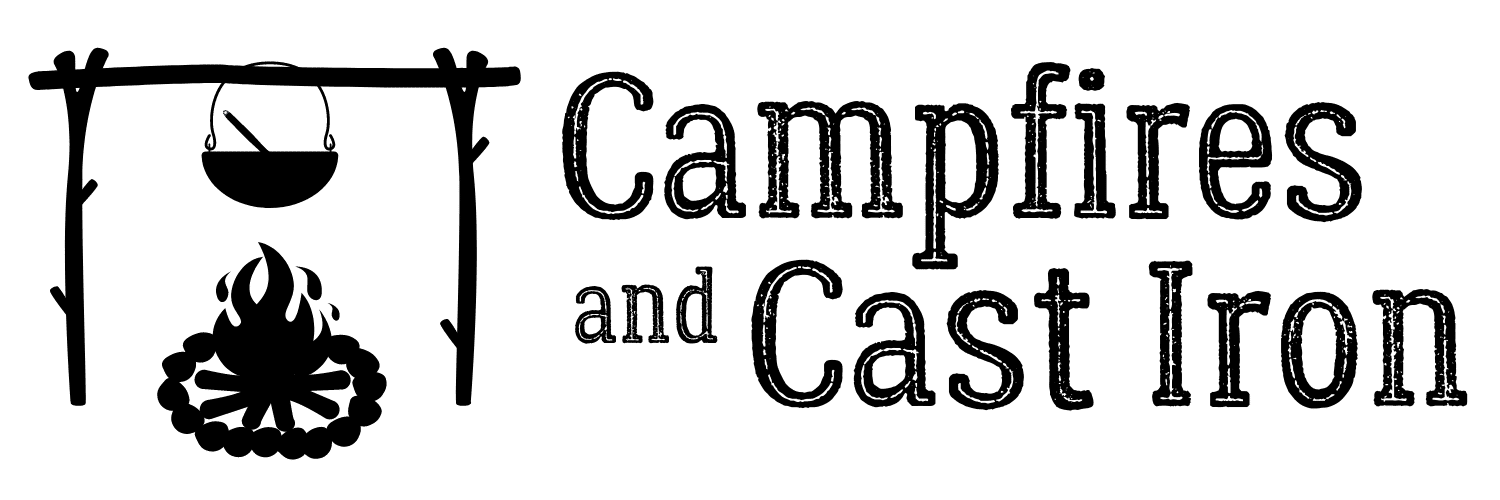Last updated on April 2nd, 2022
If you’re interested in learning how to cook with cast iron while camping, you’ve come to the right place! Cast iron cookware is one of the most popular and widely used camp kitchen essentials. After all, you can’t beat the taste of food cooked outside in a cast iron skillet or dutch oven.
In this guide, I’ll show you:
- How to select the most useful cast iron pans for camping
- Ways to prepare meals outdoors using cast iron skillets, dutch ovens, and griddles
- How to clean and store cast iron cookware at camp
- …and much more!
Why Is Cast Iron Good For Camping?
Cast iron is great for camping because it is durable, versatile, and easy to use. Cast iron skillets, griddles, and dutch ovens can be used over an open campfire, with hot charcoal, on the grill, or on a camp stove. The iron conducts and retains heat well, making it easy to sear steaks, boil and simmer stews, fry eggs, cook pancakes, and prepare lots of other tasty camping meals.
Cast iron cookware is also relatively easy to clean and maintain while camping. After cooking, simply rinse and scrub the pan with water, dry it well, and apply a thin layer of cooking oil all over the iron to protect it from dirt and moisture and prevent rust. We’ll also discuss outdoor cast iron cleaning and maintenance in more detail toward the end of this article.
It is important to note that cast iron works best for car camping where you will be parked fairly close to your campsite, or if you’ll be staying in a cabin, camper, or RV. If you will be hiking a long distance to your campsite, have storage space or weight limits, or you’re primarily backpacking or lightweight camping with minimal gear, there are lighter, more portable cookware options available to better suit your needs.
Which Cast Iron Pans Should I Take Camping?
When deciding which pieces of cast iron cookware to take camping, you’ll want to consider these factors:
- How much room do you have in your vehicle, camper, or RV to transport large cooking items?
- Cast iron cookware is heavy. How far will you need to carry it to and around your campsite?
- What type of meals will you be cooking?
- How many people will you be cooking for at one time?
Let’s take a look at the most useful types of cast iron cookware for camping – skillets, dutch ovens, griddles, and combo cookers. Understanding what each piece is capable of and best suited for will help you decide what to bring along on your next trip.
Cast Iron Skillet
The most popular and well-known piece of camp cooking equipment is probably the cast iron skillet. Available in a range of sizes and depths, cast iron skillets are perfect for cooking for one person or a large crowd.
When deciding which cast iron skillet to take camping, consider the 10 or 12-inch sizes. These are the most versatile and portable. A 10-inch skillet is a very practical size for serving two to three people. For four or more people, I recommend the 12-inch size.
Examples of camping foods you can cook easily in a skillet include bacon, eggs, pancakes, steaks, burgers, sloppy joes, stir fry, salmon patties, fajitas, and vegetable side dishes.

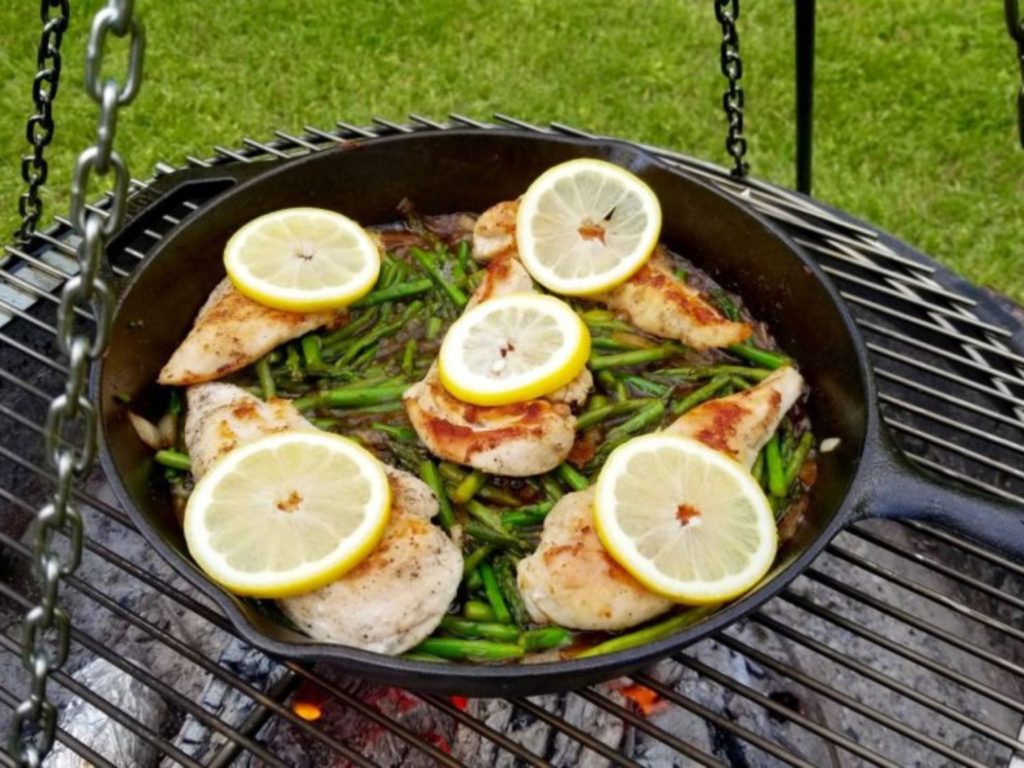
Cast Iron Camp Dutch Oven
The camp dutch oven is basically a cast iron pot with three legs on the bottom and a lid with an elevated rim. It typically has a handle for hanging over a fire via a tripod. The camp dutch oven’s legs raise it a couple of inches off the ground, providing room for charcoal or hot embers to be placed under the pot. This also helps prevent the coals from directly touching the bottom of the pot, which can cause food to burn due to the intense heat. The flanged lid keeps charcoal in place on top of it while cooking and helps prevent ashes from falling into your food when removing the lid.
Camp dutch ovens are incredibly versatile. They can be used for almost any cooking method that could be performed indoors, reducing the need for multiple pieces of cookware. Here are several examples of the best ways to cook with a camp dutch oven:
- Simmering soups and stews
- Steaming rice and vegetables
- Boiling water for pasta
- Searing steaks
- Frying chicken
- Browning ground meats
- Sauteing vegetables
- Slow-cooking roasts
- Baking bread, biscuits, pies, cakes, and cobblers
- Melting cheese on pizza, nachos, and omelets
If you’re interested in dutch oven cooking but don’t know how to choose the right size, check out my article, “What Size Dutch Oven Do I Need For Camping?”
Camp vs. Indoor Dutch Ovens
Note that a camp dutch oven is different than an “indoor” or regular dutch oven, which has a flat bottom and a slightly rounded lid without a rim. As long as an indoor dutch oven is made from solid cast iron, isn’t enamel-coated, and doesn’t contain any wooden or plastic accent pieces, it can be adapted for use outside on a camp stove, grill, or supported by rocks to create space underneath for hot embers or coals.
However, the rounded lid makes holding coals on top difficult. Therefore, the indoor dutch oven isn’t ideal for baking, melting, or slow cooking, as it can only be heated from the bottom.


Be aware that enamel-coated dutch ovens are not recommended for use over an open fire or directly on hot charcoal. Enameled cookware may not withstand these high temperatures, which can cause the enamel coating to crack, chip, and flake off. An open fire can also permanently burn or stain the enamel. Check out this article for more information on why you shouldn’t use enameled dutch ovens for outdoor cooking.
Cast Iron Griddle
Cast iron griddles come in various shapes and sizes and can be used on a grill, camp stove, or over the campfire. Griddles are most popular for making pancakes, bacon, and eggs. They are also great for cooking steaks, chicken, and burgers. The larger, flat surface area is perfect for cooking multiple items at the same time. Many cast iron griddles are also reversible, with a flat surface on one side and elevated grill lines on the other side.
Alternatively, the lids of some dutch ovens or multi-use cookers can be inverted and used as griddles. Some lids come with built-in “feet,” while others require the use of a separate lid stand. Having a camp dutch oven that can also be used as a skillet and griddle means you won’t need to take additional pieces of cookware when camping.
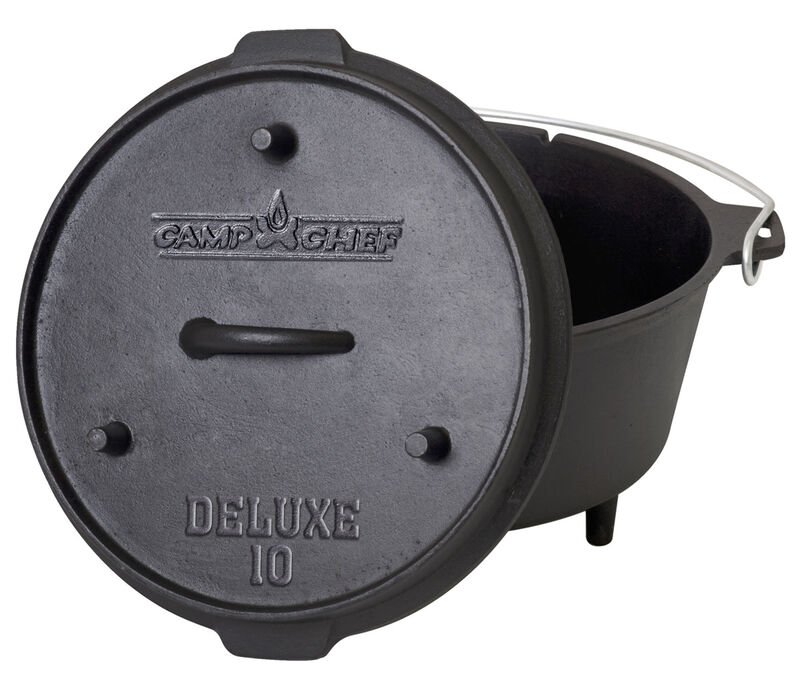


Cast Iron Combo Cooker
The combo cooker is made up of two pieces, a deep cast iron pan and a shallow skillet, that can be used separately or together.
When used separately, the deep, bottom pan is great for frying chicken and cooking stews, vegetables, chili, and more, as well as searing and browning meats. The shallow lid is perfect for bacon and eggs, stir-fry, or anything else you would regularly cook in a skillet.
When stacked together, the combo cooker essentially becomes a dutch oven. You can bake bread, pies, and desserts, cook a roast, steam vegetables, and so much more.


Can You Use Cast Iron On A Campfire?
This is a frequently asked question, and the answer is simple: Yes!
Cast iron can safely be used on a campfire. Whether it is placed directly on hot embers, elevated above the fire on a cooking grate, or suspended over a campfire by a tripod, cast iron can take the heat. Just make sure to use solid cast iron cookware without wooden, plastic, or enamel-coated parts.
Cast Iron Camp Cooking Methods
Now that you know which types of cast iron pans are best for cooking in the great outdoors, let’s look at cooking heat sources. Here are the four most common ways to cook with cast iron while camping:
Cast Iron Cooking Over A Campfire
The campfire is the most traditional and authentic method of cooking while camping. Although starting the fire, waiting for it to reach the best height and temperature for cooking, and maintaining the coals can be challenging, cooking over the campfire while enjoying the company of friends and family is always worth it.
Campfire cooking can be done in multiple ways:
Cooking Grate
Cooking grates provide an elevated surface for cast iron cookware over the fire. Many campground fire pits are equipped with built-in cooking grates that have adjustable height settings or swing-away hinges to improve heat control. There are also several styles and sizes of portable fire pit cooking grates available.
Before cooking, wait for the fire to burn down to a flame height that is slightly below the grate. This will help avoid burning your food, getting fire ashes in the pan, or accidentally catching any oil in the pan on fire.


Cooking Tripod
A camp cooking tripod has 3 sturdy legs, usually made of iron or steel, and a chain with a hook. It allows you to hang dutch ovens, coffee pots, and grilling grates over the campfire. This method works best with a tall fire, as opposed to a short flame or coals.


Directly on Hot Coals
When using this method, avoid placing the pot directly in or over roaring flames where temperatures are hard to control. Carefully use tongs and heat-resistant gloves to move some glowing wood coals just off to the side of your main fire. Place your cast iron cookware on top of the hot coals for more even cooking.

Important campfire cooking tips:
- Start your cooking fire early! – It takes at least 30 minutes from the time you light the campfire until it is ready for cooking. You’ll want to allow enough time for the fire to reduce the wood to glowing coals. The red-hot coals combined with a short flame height provide a more stable heat source ideal for cooking.
- Preheat cast iron cookware – Once your fire is ready for cooking, preheat your cast iron for about 10 minutes. Cast iron takes longer than other metals to heat up. By preheating it, you’ll be ready to start cooking with a more evenly-heated surface. Preheating cast iron is especially important for searing, frying, and sauteing.
Cast Iron Cooking With Charcoal
Cooking with cast iron using charcoal allows for more precise heat control without an open flame. Charcoal briquettes burn longer than wood campfire coals and provide a great heat source for slow-cooking in a dutch oven. Charcoal briquettes are also more uniform in size and are easy to place underneath or on top of a camp dutch oven for baking.
Make sure to download and print my free Dutch Oven Charcoal Temperature Chart to easily and accurately know how many charcoal briquettes you’ll need to achieve the desired temperature and where to place them around the dutch oven.
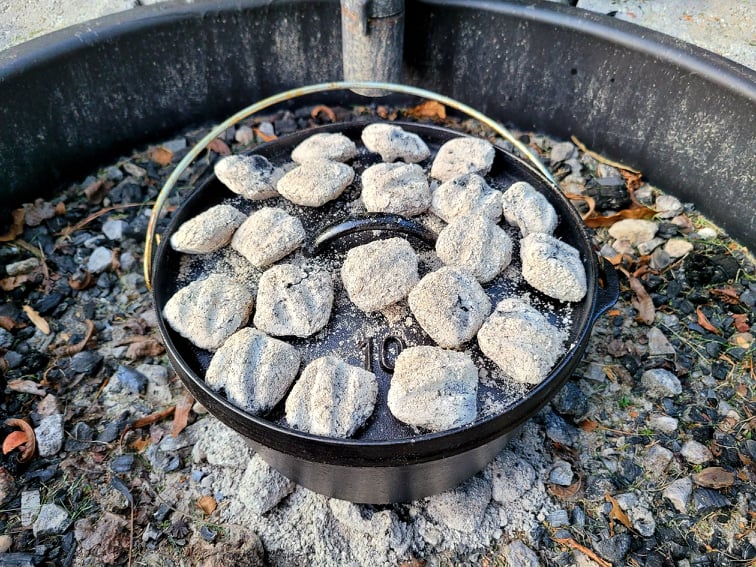
Important charcoal cooking tips:
- Lighting Charcoal – The best tool for getting your charcoal started is a chimney starter. They also come in collapsible versions to save space when camping. Check out my article, How To Use A Charcoal Chimney Starter, for step-by-step instructions.
- Don’t use Matchlight or “instant light” charcoal – Quick-lighting charcoal is coated with lighter fluid. Don’t use it in a chimney starter, as it will cause the coals to burn up too quickly.
- Add a few extra charcoal briquettes – Sometimes briquettes disentigrate too fast in the charcoal chimney. Always include a few extra briquettes above what the temperature chart recommends to account for any small or broken coals.
- Multiple batches of charcoal may be required to maintain the temperature when cooking for more than an hour or in cold or windy conditions. Light another round of briquettes in the chimney starter about 10 minutes before you plan to use them.
Cast Iron Cooking On A Grill
Cast iron cookware can also be used on charcoal or propane grills. This comes in handy if the public grill at the campsite looks a little less than sanitary. Simply light the grill, place your cast iron skillet or griddle on the grill to preheat, then cook your meal in your cast iron pan. This method is perfect for cooking steaks, hamburgers, hotdogs, chicken, or even breakfast foods like bacon and pancakes.
When using a grill with a lid, you can cook foods in cast iron skillets or dutch ovens at more precise temperatures almost like you would in your home oven.

Cast Iron Cooking With A Camping Stove
The camping stove is the fastest, easiest, and most convenient way to cook outdoors with cast iron. While cooking over a campfire or hot charcoal may be the more traditional method of camp cooking, sometimes it requires too much time and effort. Additionally, camping stoves can often be used for outdoor cooking when burn bans and campfire restrictions are in place.
Camping stoves are available in one or two-burner models, and most commonly run on propane gas. The small, one-pound propane cylinders are lightweight and easy to transport, making them the preferred choice for camping. However, for more frequent or prolonged use, adapter kits that allow you to connect a standard 20-pound propane tank to your camping stove are available.
Most camping stoves fold down for easy storage and transport. I keep my stove in a storage case to protect it from dirt and moisture and make carrying it to my campsite easier.
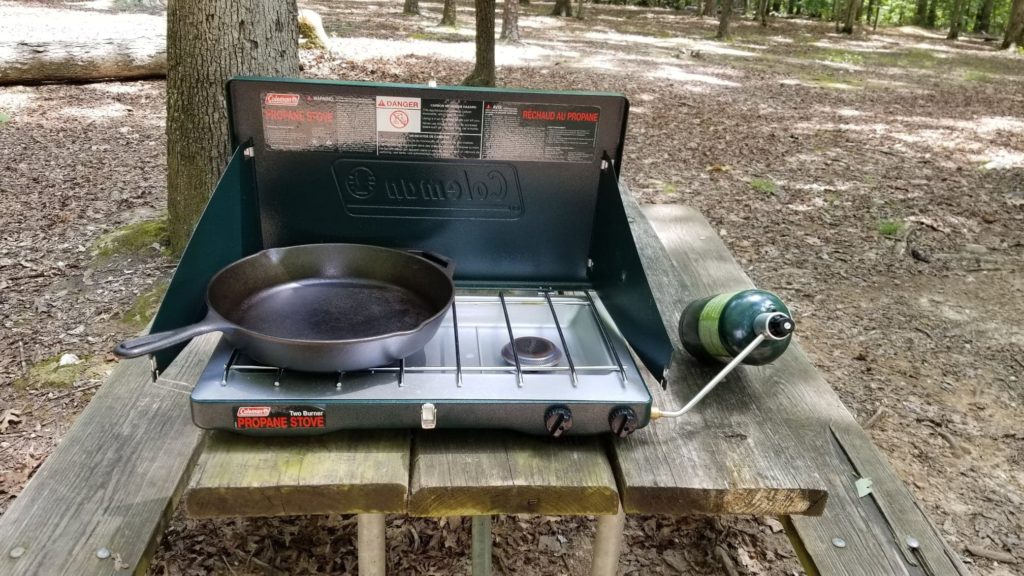
Important camping stove cooking tips:
- Camping stove burners cook HOT! – Because the burner is small, the flame is very concentrated in one area. When using cast iron on a camping stove, always use the LOWEST heat setting. Cast iron tends to heat up slowly, but then it continues to get hotter as you cook. Keep the flame low and allow the cast iron to heat up slowly. You’ll have better control over the cooking temperature, which means less chance of burning your food.
- Move the pan around and stir food frequently – Many people mistakenly believe that cast iron heats evenly. Trust me, it doesn’t! The center of the pan can be scorching hot while the outer edges are much cooler. Because the flame from a camping stove burner is so concentrated directly under the center of the pan, it’s important to carefully move the pan around a little bit every so often to heat it more evenly. You’ll also want to stir food frequently while it’s cooking to avoid burning it.
Cast Iron Camp Cooking Accessories
In addition to the cast iron camp cooking tools mentioned in the article, here are a few more accessories worth looking into. I use a combination of these items each time I go camping or cook with cast iron in my backyard fire pit, and they are truly helpful!
How To Clean Cast Iron While Camping

Clean cast iron while camping by following these five easy steps:
1. Remove any leftover food, sauce, and grease. Scrape out larger pieces of residual food with a spoon or spatula. Wipe liquids and grease out of the pan with paper towels.
2. Wash away remaining food residue. Pour water into the pan, then gently scrub it with a nylon scrubbing brush, plastic scraper, sponge, or a chain mail scrubber made specifically for cleaning cast iron. Use a mild, biodegradable soap, if desired. It won’t harm your cast iron. Rinse the pan. *NOTE* – Never pour cold water into a hot cast iron pan. It can crack the metal.
3. Dry the cast iron thoroughly with a towel or paper towels to prevent rust.
4. Heat the pan on medium-low heat over the campfire or on a camp stove for 2-3 minutes to make sure it is completely dry. Because cast iron is a porous material, moisture can still remain in the iron and cause it to rust rather quickly. In addition to ensuring the pan is dry, heating your cast iron like this also kills bacteria.
5. Protect your cast iron from moisture and rust by rubbing a very thin coat of cooking oil all over the cooking surface. After applying the oil, buff it off with a clean paper towel to prevent streaking and stickiness.
How To Store Cast Iron While Camping
Store cast iron while camping by using a protective dutch oven or skillet carrying bag, wrapping pans in old, clean towels or pillowcases, or by placing pans in brown paper bags with layers of paper towels between each piece to avoid scratching and rusting. Then, place cookware in wooden or plastic tote boxes for easy storage and transport.

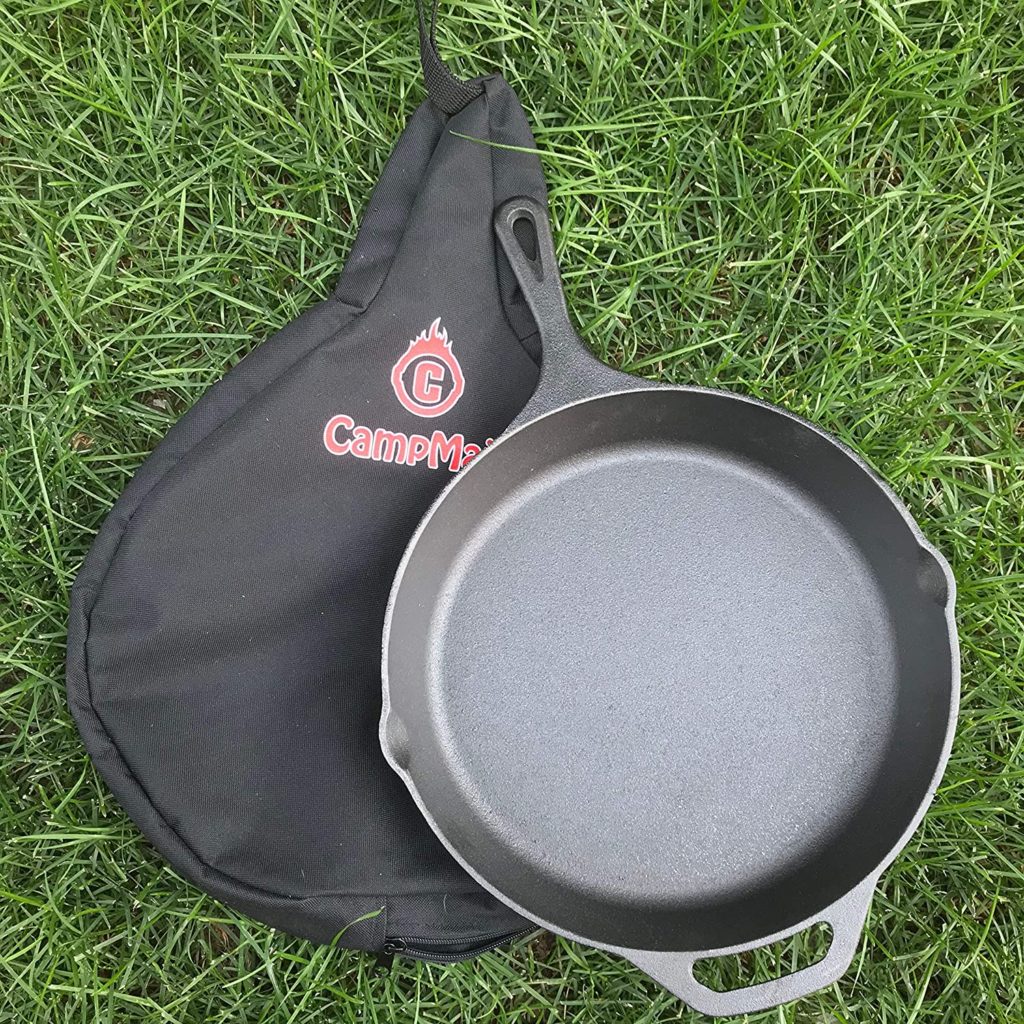
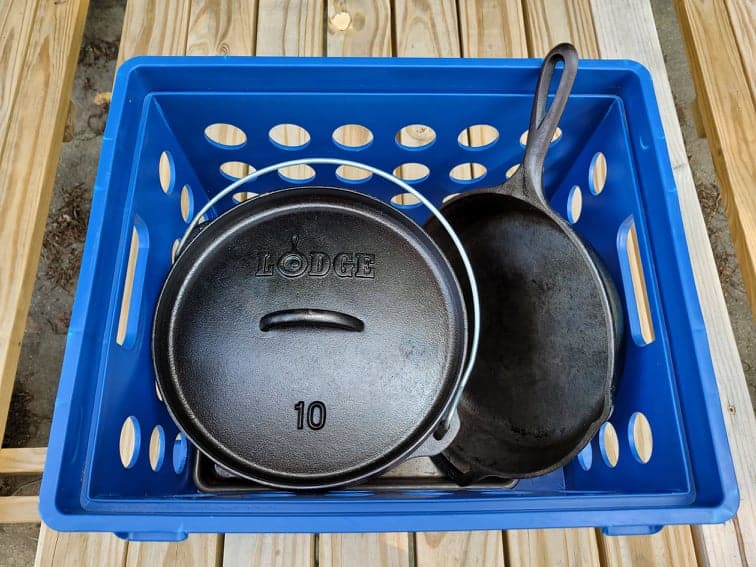
Conclusion
I hope you’ve found this guide helpful for learning which cast iron pieces to bring camping, how to cook outdoors using cast iron, and how to care for your cast iron cookware at camp. Now, it’s time to put your cast iron cookware to use! Check out the Recipes section of the blog for delicious and easy camping recipes, including allergy-friendly camping recipes everyone can enjoy.
This post may contain affiliate links. This means if you click on a link and make a purchase, I will receive a small commission, at no cost to you, that makes it possible for me to keep the Campfires and Cast Iron site up and running. Please see our disclosure policy for details.
